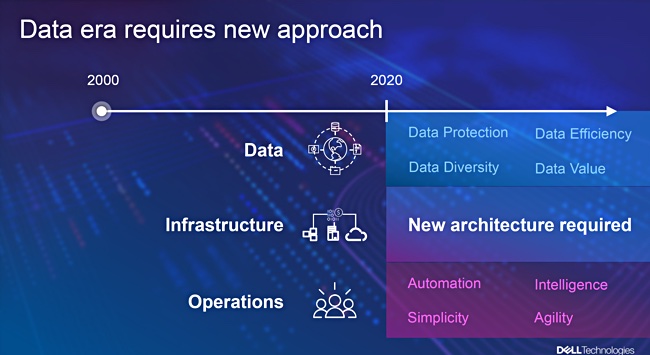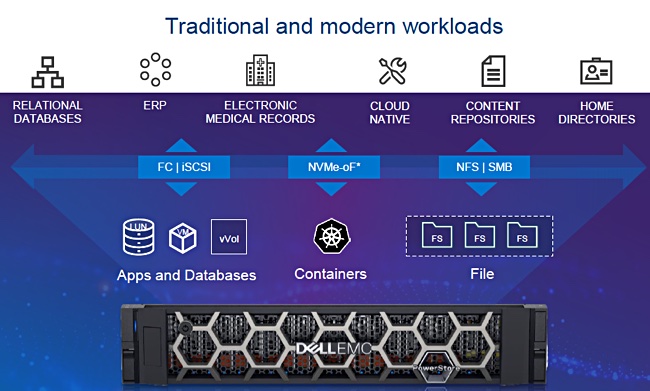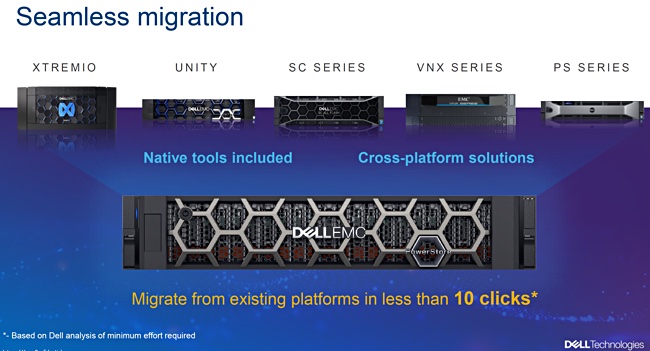Dell EMC today launched PowerStore, the much anticipated storage array line that unifies its formerly overlapping midrange products. This is the most important development in data storage hardware for many years and PowerStore will be the benchmark for the rest of the storage array industry to compare, contrast and compete with. Let the midrange storage array wars commence.
PowerStore has new hardware and software designed from the ground up, new consumption business models, management and support arrangements. Dell EMC said PowerStore – or Midrange.NEXT, as it was called before launch – is designed for a data-centric era with storage needed for physical, virtual and containerised workloads.

In a statement today, Dan Inbar, president and GM, storage at Dell Technologies, referred to a “constant tug-of-war between supporting the ever-increasing number of workloads, from traditional IT applications to data analytics, and the reality of cost constraints, limitations and complexity of their existing IT infrastructure”.

He said PowerStore “blends automation, next generation technology, and a novel software architecture to deliver infrastructure that helps organisations address these needs”.
Travis Vigil, SVP product management, told Blocks & Files: “More than 1,000 engineers worked in a collaborative effort on PowerStore, including VMware engineers.” Separate teams developed the migration facilities from existing Dell EMC midrange systems.
No more silos
Dell EMC is launching PowerStore to unify different storage hardware silos accumulated over the years as EMC acquired competitors such as Compellent (SC) and XtremIO, and Dell acquired competitors such as EqualLogic (PS) and Dell, before acquiring EMC and its ownership of VMware.
PowerStore is a migration destination from these now legacy midrange lines, and its integration with VMware means it should on that basis alone become the default midrange storage offering for existing customers.
In addition, Dell EMC has equipped PowerStore with simpler and more powerful management, support for containers and lower latency analytics that make it attractive for new workloads.
Also, a single midrange storage array line reduces the costs of maintaining separately engineered storage hardware and software product lines, notably the SC, Unity and XtremIO all-flash and hybrid arrays, which are subsumed into PowerStore. They will be maintained and supported during an unspecified transition period.
Blocks & Files asked IDC analyst Eric Burgener about ‘Power; branding: ““Dell EMC has been slowly moving to the Power brand over time with new system announcements, something that makes the optics of their product line look a little better. In 2018 they announced PowerMax, in 2019 they announced PowerProtect, and now they’ve announced PowerStore. We’ll see continued movement in this direction with future platform announcements from the vendor.”
Competition
PowerStore is an answer to and competes against all-flash storage arrays, such as:
- HPE’s Primera, 3PAR and Nimble arrays which pioneered predictive analytics,
- Hitachi Vantara’s recently updated VSP E990
- IBM’s newly-updated FlashSystem
- NetApp’s ONTAP AFF arrays
- Pure Storage FlashArray and FlashBlade and its Evergreen business model
It will also compete against Kaminario, VAST Data, Excelero, Pavilion and StorCentric’s Vexata arrays.
In general, the mainstream storage hardware suppliers have single OS all-flash product lines, with the notable exceptions of HPE and – until today – Dell EMC. They have all developed subscription pricing models and are moving towards flexibly timed, data-in-place upgrades. They have varying degrees of public cloud integration and most vendors have embraced Kubernetes, with CSI (container storage interface) plugins.
PowerStore enables Dell EMC to tick these boxes with similar or better features: a single OS product line, flexible data-in-place, upgrades, subscription pricing, public cloud integration and Kubernetes support.
Dell EMC has probably the best integration going with VMware and the unique ability to run application VMs in the array (see below). If it has provided a sufficient performance boost, and the migration facilities are as good as claimed, PowerStore should find a natural home in the Dell EMC customer base and enable the company to gain new customers.
We asked Burgener about PowerStore coming up against NetApp: “I don’t think PowerStore will compete against the NetApp EF Series,” he replied. “The EFs are typically sold for dedicated high performance workloads that don’t require a lot of enterprise-class data services. SANtricity, the EF storage OS, is more limited in that sense, and they are block-only. PowerStore is a unified (block/file) system with much more comprehensive data services. A single EF can handle 2M IOPS whereas it takes an appliance pair with PowerStore to do that.
“Latencies are probably pretty close if you put Optane SSDs into PowerStore (the EF boasts sub 100 microsecond latencies with NAND flash-based NVMe SSDs and NVMe-oF as the host connection). I do think the PowerStore models would compete more with the NetApp A220 and A400 models though (both of which run ONTAP).”
Let’s delve into PowerStore’s hardware, software, management, monitoring, migration, consumption and upgrade facilities.
Hardware scaling surprise
PowerStore has a standard dual-controller architecture with clusterable appliances, which scales in a novel fashion.
There are five PowerStore models – the 1000, 3000, 5000, 7000 and 9000. They each have exactly the same capacity as the others. In other words, there is no capacity scaling across the model range.
All five PowerStores have four processors, with two per controller. But they vary by compute cores and memory; the 1000 has 32 cores, the 3000 gets 48, the 5000 given 64, the 7000 has 80 and the 9000 has 112.
DRAM grows in the same way, with 384GB for the PowerStore 1000 and steps of 768GB, 1,152GB, 1,536GB across the range to the 9000’s 2,560GB. Thus performance, but not capacity, grows across the range.
The base enclosure is a 2U x 25-slot unit and two active:active controllers or nodes. The controllers use Xeon Scalable processors and these process data from dual-ported NVMe NAND or Optane drives.

There can be 1.92TB, 3.84TB, 7.68TB or 15.36TB NAND SSDs or 375GB or 750GB Optane drives. All the drives are self-encrypting.
Providing scale-up capacity are up to three 25-slot SAS SSD expansion cabs. They connect to the base box across a redundantly paired four-lane x 12Gbit/s SAS backplane, which provides continuous drive access to hosts in the event of node or port failure. The maximum drive count is 96 and SSD capacities are 1.92TB, 3.84TB and 7.68TB.
In effect we have two tiers off flash storage; a fast NVMe drive tier and a slower SAS drive tier.
Burgener told Blocks & Files: “I believe they also allow HDDs in the expansion cabinets, making this system what IDC calls a Fusion Hybrid Array (FHA).”
Data reduction is provided in two ways. Compression is hardware-assisted, using Intel QuickASsist Technology (QAT) hardware. The PowerStoreOS software also provides in-line, always-on deduplication.
Dell guarantees a 4:1 data reduction ratio, so the capacity numbers are:
- Base enclosure: up to 384TB raw, up to 1,536TB effective
- Expansion cab: up to 192TB raw, up to 768TB effective
- Overhead for virtual RAID, spare space, system/metadata: about 20 per cent
- Total capacity: up to 718TB usable per appliance
The total raw capacity combines 384TB of NVMe flash and 576TB of slower-access SAS flash.
Dell is adding NVMe-over-Fabrics access at a future data but the full benefit is restricted to the base enclosures only.
Ports, RAID, availability and performance
PowerStore supports RAID 5. An appliance can have up to 16 x 16/32Gbit/s Fibre Channel ports or 24 x 10Gbase-T iSCSI or 24 x 10/25GButE viSCSI ports. The overall appliance port count maxes at 24.

With redundant components, PowerStore has a six ’nines’ (99.9999 per cent) availability rating.
Dell said a PowerStore 9000 four-appliance cluster with all-NVMe drives is seven times faster than the Unity XT 880 all-flash array, when running a 70:30 random read and write IO mix and active compression and de-dupe.
Burgener told us: “If you just compare PowerStore to the previous Unity XT, it’s a very nice price performance and scalability bump with some interesting new features such as hardware-assisted compression, AppsON, and four nodes instead of just two.”
A Dell spokesperson told Blocks & Files: “PowerStore performance, like all storage systems, varies by workload (block size, mix of IO, etc.). In the particular workload used to compare to Unity XT, we are seeing over 2 million IOPS with no impact to inline deduplication and compression… we expect our customers to see less than 500 microseconds of response time during normal storage operation.”
Burgener said: “From the numbers that Dell EMC shared, each appliance pair can handle up to 2 million IOPS and they can extend that to up to 4 nodes for a total of around 4 million IOPS (that’s a federated cluster like clustered ONTAP, not a true distributed environment like IBM Spectrum Scale).”
How does PowerStore compare to the high-end PowerMAX array? An entry level PowerMAX 2000 supplies up to 7.5m IOPS, sub-100μs read latency and 1PB effective capacity, delivers up to 7.5m IOPS, has sub-100μs read latency and 1PB effective capacity. Those figures make PowerStore look decidedly…midrange.
Clustering
PowerStore appliances can be clustered to provide scale-out capacity with up to four appliances per cluster.

The clustering scale-out depends upon a software-defined configuration into X and T systems.
The PowerStoreOS runs on the bare PowerStore metal in T systems, which supply block, VVOLs and file storage, and represent the standard deployment mode. File storage runs as a container.
The supported file access protocols in T mode are; NFSv3, NFSv4, NFSv4.1; CIFS (SMB 1), SMB 2, SMB 3.0, SMB 3.02, and SMB 3.1.1; FTP and SFTP. The file stack in PowerStore will become the standard file stack across Dell EMC’s portfolio.
PowerStore T model appliances can be configured as either Block Optimized or Unified (block and file). The T-mode system supports 3-way NDMP backups. 3-way NDMP transfers both the metadata and backup data over the LAN. A white paper explains the file facilities in more detail.
PowerStore T clusters:
- 96 drives per appliance,
- four appliances per cluster
- 898.56TB raw capacity per appliance
- 718TB usable capacity per appliance
- 2.8PB effective capacity per appliance after overhead for virtual RAID, etc.
- 11.3PB effective capacity per cluster
PowerStore X clusters
In PowerStore X systems an ESXi hypervisor runs on the bare controller metal and the PowerStoreOS runs as a VM inside it. A certain amount of the controller compute power is reserved for this PowerStore VM. According to Dell, PowerStore is the only storage array with such a built-in hypervisor.
The X models do not scale out and provide block and VVOLs storage but not file-level access. Scale-out on PowerStore X will be available in a future release.
PowerStore X system:
- 96 drives per appliance
- one appliance per cluster – in effect, no clustering for now
- 898.56TB raw capacity per appliance
- 718TB usable capacity per appliance
- 2.8PB effective capacity per appliance
AppsON
With PowerStore X models the array can run applications in other VMs alongside the PowerStoreOS VM, and Dell calls this AppsON – applications on the array. This software means compute is being brought to the storage, according to the company.
This compute-in-storage idea has been tried before, notably by Coho Data which crashed in August 2017. And in 2013, EMC touted the addition of compute to VMAX and Isilon storage. It never delivered the capability and instead developed hyperconverged VxRail systems, using VMware’s VSAN software.
According to Dell, AppsON is a good fit for data-intensive workloads with analytics run locally on the array from streamed-in data sources: Splunk, Flink and Spark, for example. This is useful in internet edge PowerStore deployments.
A Dell spokesperson told us: “A native file import technology is planned for an upcoming release.” Scale-out will also be supported in a future release.
The lack of file support is not seen as a problem by Scott Sinclair, an ESG analyst: “I would expect the majority of implementations to leverage the block-based storage. If I am running an app in a VM with VVOLs, I typically care more about the storage capabilities, performance, and features, than I do about the underlying storage protocol.”
A PowerStore data sheet diagram confirms any VMware virtualized application can run on PowerStore:

This capability brings controller sizing considerations in its wake. Typically, customers will buy an array like PowerStore with controller power and array capacity sized for their storage workloads. A single node PowerStore X is effectively a server with NVMe direct-attached storage (DAS) and potential direct-access SAS SSD expansion storage. It could be sized like any other server plus DAS, but at the same time it is an array supporting host server access. Sizing for these two workloads could be tricky.
Dell’s VxRail hyperconverged (HCI) systems, are built for general purpose compute and storage needs. PowerStore AppsON is for specialised storage-specific workloads such as anti-virus checking, data protection, and latency-sensitive, real-time analytics at edge locations.
In Burgener’s view there will be “a little confusion between which HCI product to buy, but note that Dell EMC emphasizes that PowerStore has more enterprise class storage capabilities than the HCI products”.
Dell said hypervisor mode provides storage OS abstraction – a hint perhaps that other storage operating systems could be used in the system?
Through its integration with VMware, PowerStore supports VAAI, VASA, VVOLs and the VMware Cloud Foundation. Also, VMware’s bare metal ESXi hypervisor runs on the array and PowerStore works with vRealize Orchestrator. This tight integration enables VMware-skilled admin staff to quickly adapt to PowerStore, Dell said.
Software power station
Dell has developed PowerStoreOS to support legacy and cloud-native workloads. The OS has a high degree of automation and, naturally enough, VMware integration.
PowerStoreOS has a modular, cloud-native architecture where individual OS components are isolated as microservices. This containerised approach will enable Dell to add functions such as deployment modes more quickly. Burgener said new features “may come out faster as well -because they don’t have to ship an entire new storage OS, just the feature in a module which communicates with the rest of the storage OS through APIs.”
PowerStoreOS supports access by physical and virtual server applications, databases and containerised applications via a CSI plug-in.

PowerStoreOS has thin provisioning and always-on data deduplication. In conjunction with hardware compression, this provides a guaranteed 4:1 average data reduction ratio.
The array software has Dynamic RAID capability, offering RAID 5 (4+1/8+1).
PowerStoreOS supports automated workflows. IT and DevOps users can programmatically provision PowerStore resources from an application toolset such as VMware, Kubernetes and Ansible. PowerStore resources are available from a self-service catalogue.
Snapshot and replication
PowerStoreOS has a newly-developed snapshot engine and built-in replication. It can also produce thin clones. The snapshot facility integrates with Dell EMC’s Avamar and Networker backup products.
PowerStore AppsON VMs can be moved via vMotion to VxRail hyperconverged systems, any PowerEdge ESXi server system and VMware Cloud Foundation or vice versa. That means PowerStore data or storage instances can be moved from the edge to the core to the cloud.
PowerStore is supported with Dell EMC Cloud Storage Services, which connects the system directly to the user’s public cloud as a managed service. Cloud Storage Services can provide DRaaS (disaster recovery as a service) to VMware Cloud on Amazon Web Services.
PowerStore will – “this summer” – become a storage option in PowerOne, Dell’s autonomous infrastructure cloud platform.
Management and monitoring
The PowerStore array has built-in automation and uses machine learning (ML) to optimise system resources and make it more autonomous. The ML engine handles initial volume placement, migrations and issue resolution. It also monitors and fine-tunes array performance.
ML is used after auto-discovering a new PowerStore cluster node to rebalance the cluster’s data storage workload across the now enlarged cluster. The ML engine makes data placement recommendations and up to 99 per cent of storage admin time can be saved in such volume rebalancing, according to Dell.
As we note above, PowerStore has fast NVMe drives in the base enclosure and slower SAS drives in the expansion cabinets. We asked Dell if the PowerStoreOS machine learning data placement facility takes account of this and places the hottest data in NVMe flash and cooler data in SAS flash during migration? Is there movement of cooler data from NVMe flash to the SSD flash as fresh hot data comes into the system?
A spokesperson told us: “The PowerStore OS automatically adds [SAS] flash drives to a combined common pool and automatically places data across the pool.” That indicates there is a single pool – no separate NVMe and SAS storage tiers.
ESG’s Sinclair said: “PowerStore’s NVMe storage, combined with its data reduction technology, [means] the NVMe performance offered by a single system is large enough to meet most application demands. And if it isn’t and if I still needed NVMe, I would be more likely to take advantage of the scale-out design to maximize performance as I increased capacity.”
PowerStore uses Dell’s CloudIQ SaS storage monitoring software to spot anomalies before trouble occur, detect failures, optimise operations and predict future capacity needs. Dell plans to extend CloudIQ’s scope beyond storage arrays to include monitoring servers and switches.
Migration
According to Dell EMC, migration from PS, SC, Unity, VNX and XtremIO arrays to PowerStore is completed in seven-to-10 clicks. Hosts are remapped transparently, and offloaded, keeping workload performance high during the data transfer.

Native tools for this are included in the PowerStoreOS. There is Native Block migration from Dell EMC Unity, VNX, SC Series and PS Series. A Dell spokesperson told us the company will ship this capability for XtremIO – “shortly”.
A range of other migration methods include VPLEX and PowerPath/ME to host-based tools such as vMotion and Linux LVM, and migration offerings from Dell Technologies Services.
Datadobi, a storage software migration specialist, told Blocks & Files it is an official migration system, “fully tested and confirmed with Dell PowerStore”. Datadobi could be considered as a potential migrator of data from non-Dell EMC arrays to PowerStore such as HPE 3PAR, Nimble, and NetApp.
Deployment
PowerStore can be deployed at internet edge sites, where rack-mounted systems are supported, and also in core data centres. In deployment it could run alongside VxRail systems and servers running ESXi and integrated with VMware Cloud Foundation systems.
The public cloud is available as a secondary or backing store for PowerStore. Dell EMC Cloud Storage Services directly connects PowerStore to all major public clouds including Amazon Web Services (AWS), Azure and Google Cloud as a managed service. Cloud Storage Services provide data recovery as a service (DRaaS) to VMware Cloud on AWS.
Managed service providers can use PowerStore to deliver storage services or colocate it with the public cloud for use by public cloud compute.
Consumption and Upgrades
Dell EMC offers various array payment arrangements, including Pay As You Grow and Flex on Demand metered usage. There is also a pay per use environment across the customer infrastructure. Customers can choose between two flexible pay-per-use consumption models with short-and-long term commitment options, including a new one year term for flexible consumption.
Customers can scale up a PowerStore array by adding SAS SSD expansion shelves. Dell has three Anytime Upgrade options with data-in-place upgrades;
- Next-Gen: Upgrade appliance nodes (controllers) to next generation equivalent models
- Higher Model: Upgrade to more powerful nodes within the current generation
- Scale-Out: Apply a discount to expand your environment with a second system equal to current model.
No additional purchases or licensing is required and upgrades can take place at anytime within a PowerStore user contract, without triggering contract renewal. All three upgrades are non-disruptive, preserving existing drive and expansion enclosures.
(Note that upgrades are available after 180 days and they require purchase of a minimum three-year ProSupport Plus with Anytime Upgrade Select or Standard add-on option at point of sale to qualify.)
Dell EMC claims that PowerStore users will never need to migrate or endure forklift upgrades again, and there is no downtime with data-in-place hardware and software upgrades.
PowerStore is generally available globally and will be included as an option for PowerOne autonomous infrastructure this summer.
Software futures
PowerStore does not yet support NVMe-over-Fabrics. Dell said NVME-oF capabilities will come in a future version of the software.
PowerStore X scale-out will also come in a future release, a Dell spokesperson told us: “At first, we believe that, given AppsON is a new capability, most early deployments will only require single nodes. When customers are ready to expand, we plan to be ready, and new Anytime Upgrades as part of our Future-Proof Program are designed to make it easier and more cost-effective to add capacity.”
At that time a scale-out clustered PowerStore X will effectively be a hyperconverged system, like VxRail.
Dell will also develop a software-only version of PowerStoreOS, capable of running on industry-standard servers and also, we suppose, in the public cloud. That will extend the actual PowerStore environment from edge and core to the cloud.








